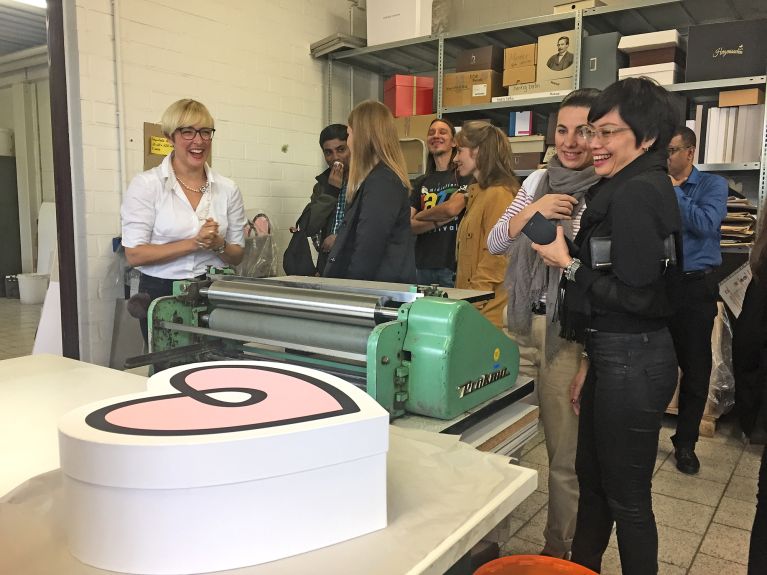Trademark: Hand-crafted
10 international guests travelled to Dresden, Meissen and Berlin to find out more about “German design” and German craftsmanship.

At Welter, a company right in the heart of Berlin, the walls glitter. The modest office of this manufacturer of “one-off walls” in the rear courtyard of an old factory site is resplendent with glass and gold. Welter produces everything by hand – customized wallpaper and spectacular wall decorations for luxury hotels and upscale shopping malls throughout the world, for the stage at the Oscar ceremony, for instance, for fashion labels such as Chanel and for affluent private clients in the Arab world. The 10 international guests on the Federal Republic of Germany’s Visitors’ Programme touch the walls in awe and listen to what the marketing manager has to say with something approaching incredulity. This Berlin-based manufacturer has only 10 craftsmen executing its commissions – stuccoers, painters, colour and textile designers and sculptors.
Fine art is also the kind of everyday work from which young people can and should be earning money.
The adjacent workshop is full of buckets of paint and rolls of wallpaper. Long tables are covered with samples and knives. One employee is cutting little panels to shape, multiple layers of bright stains on the floor bear witness to years of intensive production. “The people who work here are obviously not afraid to get stuck in,” comments José Ricardo Castellon Osegueda. the designer from El Salvador who advises the Office of Culture for his government, very taken with the work atmosphere at Welter. “Fine art is not everything – as we are currently trying to explain to the young people in our country. There is also the kind of everyday work from which they can and should be earning money.”
Combining the traditional with the modern
“German Design – German brands, be they skilled craft brands or medium-sized businesses” – this is the title of the themed trip which forms part of the Federal Republic of Germany’s Visitors’ Programme in September 2017, offering journalists and marketing experts from all over the world insights into some very special craft workshops in Berlin, Dresden and Meissen. The tour of the Meissen Porcelain Manufactory followed by a meal served on traditional tableware particularly impressed the guests. “The way that the traditional meet the modern here is fantastic,” reports Jana Ferrari from Slovakia. It is her job as deputy director responsible for marketing and PR at the headquarters of her national folk art workshop to encourage the same kind of connection in her own country. “We want our traditional skilled crafts to be able to hold their own in the modern markets.”
Ferrari reports that there is considerable demand for hand-crafted products in her home country but admits that small businesses are still not capable of surviving on the open market. And she attentively listens to the lecture by Dirk Palige, one of the managers at ZDH, the German Confederation of Skilled Crafts. “What impressed me most was the various types of vocational training and the quality management, which, in Germany, is guaranteed by the chambers of skilled crafts,” says Ferrari. “In Slovakia it is still too often the case that skills are passed on from father to son. With us the training is not professional enough which means that many skilled crafts are threatened with being lost forever.”
According to Latvian Liva Sturmane the esteem in which skilled crafts are held in Germany is striking. Sturmane coordinates the forum “Best Exporting Brands in Latvia” –a forum aimed partly at strengthening local craft enterprises and small businesses – and she is at great pains to encourage companies in Latvia to collaborate more closely with Germany. Kazakh journalist Nataliya Shirinskikh is also calling for more international cooperation in the field of training courses and programmes for craft enterprises. Indeed, Shirinskikh, the editor-in-chief of the news agency “Kazakhstan Today” sees similar challenges to Palige for skilled crafts in her country– demographic change, questions of tax on the international markets and increasing digitization.
Manufactured locally and sold globally
And as Ferrari stresses, there are, throughout the world, on the one hand, opportunities for locally produced goods and, on the other, a number of challenges. “In the globalized world, people are looking for what sets things apart from mass-produced goods from China – craftsmanship, tradition, sustainable ecological production, individual design.” As is the case in Germany, this development needs to be encouraged.
The guests at Welter’s workshops have a lot more specialist questions, questions such as the kind of pastes used, how to clean the wallpaper and the advertising strategies in place. And they are surprised by the fact that all the materials used are made in Germany. For newspaper editor Shawkat Hossain Masum from Bangladesh, this small company with its large ambitions have finally laid one cliché to rest. “When I thought about German industry I used to think about large machines, factories and heavy industry. Until now, I barely spared a thought for the country’s successful craft industry.”
